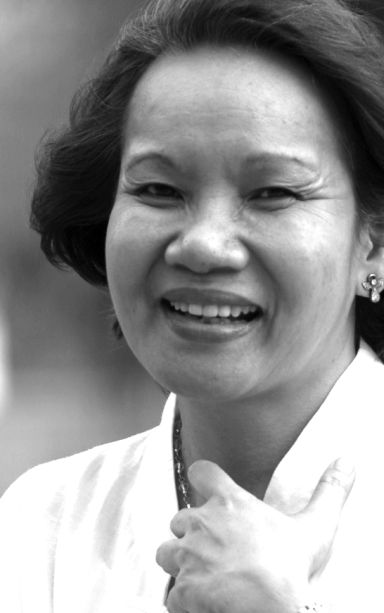
LOGARTA
Our educators, our young people, especially the females, are blessed to have the heritage cards. These can be inspirations as they work for their dreams. These emphasize that there are no limits to their possible explorations and personal adventures because they are females or have limited resources.
For those inclined towards entrepreneurship, we have this group of women: Maria Rallos, Honoria Mag-usara, Juliana Perez-Suico and Doña Modesta Singson-Gaisano. And here are what the cards say about them.
“When her husband died Maria Rallos remained an energetic and enterprising woman. She traded in root-crops, owned and operated at one time Teatro Junquera, Cebu’s first and premier theatre-cum-cinema; owned the city’s first sinamay store; and constructed houses for rent, originating (it is said) the ‘bamboo chalet’ type of housing popular with the Americans in the 1900s.”
She was “particularly interested in women’s education and self-development.
To this end, she authored a book on hygiene and etiquette and wrote Lagda sa Pagpanluto a large and pioneering 510-page recipe compilation of Cebuano cooking that ranges from foreign to local and from the more elaborate to the most humble of fare.
Characteristic of the author, the book includes advice for women not only on matters of food preparation and household management but social and community responsibility.”
Many of us might be interested in the beginnings of our famous masareal and otap, here are the stories of the women who started them.
Juliana Perez-Suico founded Didang’s Masareal in the early 1900s as a cottage industry in Mandaue City.
“Masareal is a sweetmeat or soft candy originally made of a few measures of saucepan boiled peanuts, mixed with refined sugar.
Primitive tools were used in the production process then. Bottles were used to mash, roll and mix the ingredients, and only dried banana leaves were used to wrap the finished products.”
Upon Juliana’s death, “her daughter, Gerarda Perez-Suico took over the business.”
The “production of this Mandaue delicacy is now highly mechanized and it is produced in bulk, but it still has the hallmark of the industriousness of Juliana Perez-Suico.”
“‘Shamrock’ is the name of a company set up by Honoria Mag-usara Paras during the pre-war together with an Irishman who immigrated to Cebu.”
During the war when she had to “find a way to feed her family, she ventured into the food business in her hometown of Barili in Cebu selling plain bread baked from a makeshift work area in her house.”
After the war, “she ventured into the production of otap, the recipe of which she had learned from a baker who worked for her.”
“Modesta Singson-Gainsano and her husband Jose Sy Lingkee, started in business with a modest general merchandise store in San Nicolas in 1933.
As it prospered, it relocated to downtown Cebu City.
With her husband’s death Dona Modesta had to fill the role of matriarch of both a family and a business.
Bearing the names of White Gold and Gaisano, the family enterprise expanded into the southern Philippines’ largest chain of ‘superstores.’
Its hallmark has been that of providing mass consumers with quality merchandise at the lowest price.”
At the same time, she “placed a premium on her involvement in community affairs.” Among other commitments, she has “provided scholarships to indigent students.”
But business is not the only world Cebuanas have been involved in. In politics we have Librada Legaspi, “Indefatigable Town Builder.”
“Spanning a period of almost 30 years, Ms. Legaspi-Pace’s political career as town mayor of Barili, Cebu had been long (1960–1978 and 1988–1998) and full of accomplishments, with numerous projects that transformed a sleepy 6th class town into a bustling 4th class municipality.
Considered a jewel in her crown is the completion of the Barili Municipal Hall without burdening the Municipal treasury and the townspeople.
She created 21 more barangays and linked these to the poblacion with feeder roads and bridges and an enviable water system, using researches as key to harness valuable sources of water for Barili.”
Others did not hesitate to join politics even in difficult times like Nenita Cortes Daluz. Others like Sr. Maria Belen E. Alcoseba, ICM, organized women, worked for their empowerment, campaigned together with others like Atty. Arbet Sta. Ana-Yongco as women advocates fighting violence against women.
Actually, in the heritage cards, young Cebuanas can learn about daring Cebuanas who excelled in sports as well as in the different fields of art. Visitacion Badana Ribagorda “won the first gold medal in track and field in the Third Asian Games”; Josephine de la Vina also made the country proud in the Asian games and took part in the Olympics.
There are very many personalities to know and learn of from the heritage cards.
It is a useful resource for local history and gender studies.
It should actually encourage other localities to prepare heritage cards which are very handy for students to deal with.
It was good that the Cebu provincial government together with the Legal Alternatives for Women Center had been willing to invest resources in their preparation.
There are actually two sets.
The preparation of the first set was led by Dr. Erlinda Kintanar-Alburo and the second set — an expanded one — led by Dr. Esther Balgue-Velasquez; both times it had been a team effort.